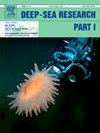东海深海鱼类的营养分配与汞积累
IF 2.1
3区 地球科学
Q2 OCEANOGRAPHY
Deep-Sea Research Part I-Oceanographic Research Papers
Pub Date : 2025-02-21
DOI:10.1016/j.dsr.2025.104473
引用次数: 0
摘要
深海,以黑暗、低温、有限的食物供应和极端的压力为特征,庇护着各种各样的生命形式。深海鱼类已经进化出独特的适应能力,在这些恶劣条件下茁壮成长,在海洋生态系统和生物地球化学循环中发挥着至关重要的作用。采用稳定同位素分析(SIA)和总汞(THg)浓度对东海11种深海鱼类的营养生态和汞动态进行了研究。我们的研究结果显示,在所研究的物种中,营养生态位有显著的重叠,但也有明显的例外,表明存在竞争和资源分配的情况。鸭鼻Coelorhynchus表现出相对广泛的营养生态位,表明其具有通才性的摄食策略,而信天翁Chlorophthalmus albatrossis和microchir Neoscopelus则表现出更专门化的生态位。我们基于δ13C和δ15N值以及THg浓度确定了4个不同的营养公会,这些公会强调了深海群落中生态位分化和资源共享的复杂相互作用。汞作为一种额外的生物指标提供了对摄食策略和营养水平的宝贵见解,突出了其在区分生态位方面的有效性。THg浓度与总长度在某些物种中呈正相关,但并非在所有物种中都呈正相关。在群落水平上,THg浓度与营养水平和生境密切相关。值得注意的是,底栖鱼类的THg浓度明显低于中上层鱼类,这可能是由于THg在ECS内的复杂分布,表明THg随深度变化的复杂性。我们的研究结果表明,垂直栖息地划分和饮食偏好如何调节深海鱼类物种之间的竞争和共存。这些发现促进了我们对深海生态系统营养结构和功能的理解,同时为保护和管理策略提供了见解。本文章由计算机程序翻译,如有差异,请以英文原文为准。
Trophic partitioning and mercury accumulation in deep-sea fishes of the East China Sea
The deep sea, characterized by darkness, low temperatures, limited food availability, and extreme pressure, harbors a diverse array of life forms. Deep-sea fish, which have evolved unique adaptations to thrive in these harsh conditions, play a crucial role in marine ecosystems and biogeochemical cycles. This study investigated the trophic ecology and mercury (Hg) dynamics of eleven deep-sea fish species in the East China Sea (ECS) using stable isotope analysis (SIA) and total mercury (THg) concentration. Our findings revealed significant overlap in trophic niches among the examined species, with notable exceptions indicating instances of competition and resource partitioning. Coelorhynchus anatirostris exhibited a relatively broader trophic niche, suggesting a generalist feeding strategy, while Chlorophthalmus albatrossis and Neoscopelus microchir displayed more specialized niches. We identified four distinct trophic guilds based on δ13C and δ15N values, as well as THg concentrations, which underscore the complex interactions of niche differentiation and resource sharing within the deep-sea community. The incorporation of Hg as an additional bioindicator provided valuable insights into feeding strategies and trophic levels, highlighting its effectiveness in distinguishing ecological niches. Positive correlations between THg concentration and total length were observed in certain species, but not across all. At the community level, THg concentrations were closely associated with trophic level and habitat. Notably, THg concentrations in demersal fish were significantly lower than those in mesopelagic fish, likely attributable to the intricate distribution of THg within the ECS, suggesting the complexity of THg variation with depth. Our results demonstrate how vertical habitat partitioning and dietary preferences mediate competition and coexistence among deep-sea fish species in the ECS. These findings advance our understanding of deep-sea ecosystem trophic structure and function while providing insights for conservation and management strategies.
求助全文
通过发布文献求助,成功后即可免费获取论文全文。
去求助
来源期刊
CiteScore
4.60
自引率
4.20%
发文量
144
审稿时长
18.3 weeks
期刊介绍:
Deep-Sea Research Part I: Oceanographic Research Papers is devoted to the publication of the results of original scientific research, including theoretical work of evident oceanographic applicability; and the solution of instrumental or methodological problems with evidence of successful use. The journal is distinguished by its interdisciplinary nature and its breadth, covering the geological, physical, chemical and biological aspects of the ocean and its boundaries with the sea floor and the atmosphere. In addition to regular "Research Papers" and "Instruments and Methods" papers, briefer communications may be published as "Notes". Supplemental matter, such as extensive data tables or graphs and multimedia content, may be published as electronic appendices.

 求助内容:
求助内容: 应助结果提醒方式:
应助结果提醒方式:


